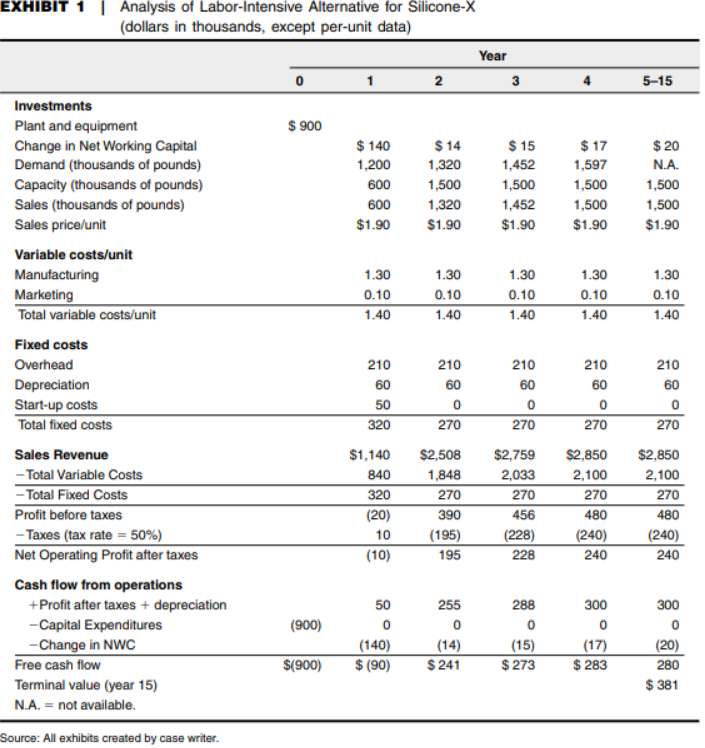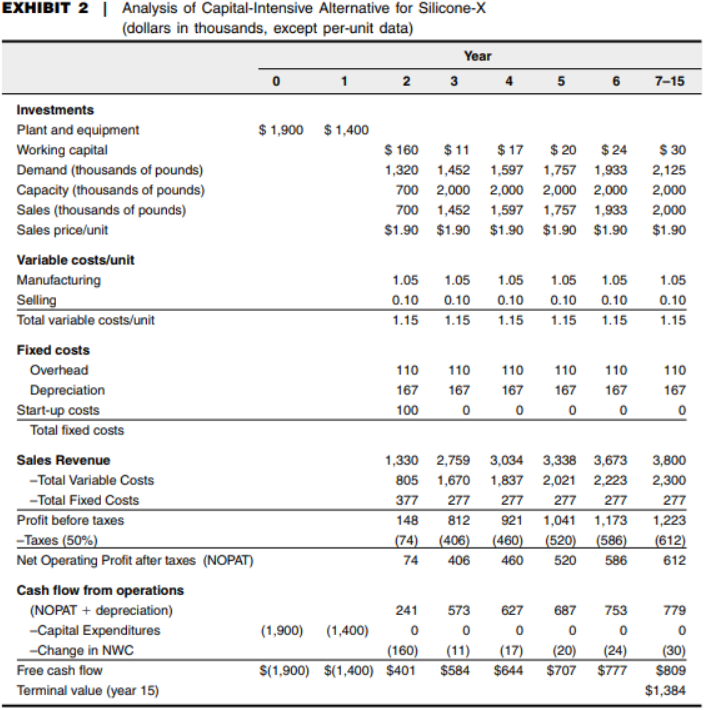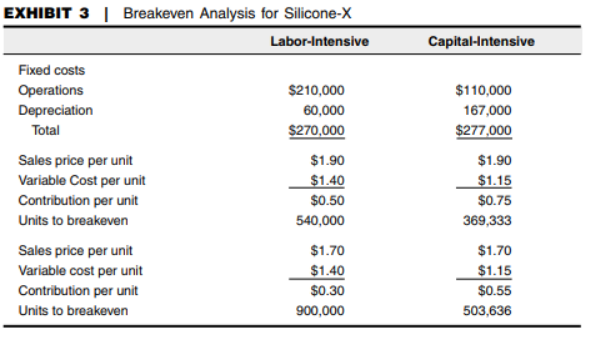| Jacobs Division | | | | | | |
| Questions | | | | | | |
| 1. Use Exhibit 23.1 and Exhibit 23.2 to compute the NPV of the labor-intensive alternative and the capital-intensive alternative. |
| 2. How is capital budgeting done at Jacobs ? Where do the projects come from ? | | | |
| 3. What are the discount rates used by Jacobs for 1) cost reduction, 2) new products, and 3) Reynolds. Is the use of multiple discount |
| rates acceptable ? Why or why not ? | | | | | |
| 4. Evaluate the NPV versus Competitive Advantages of the proposed project. Should be project be selected ? | |



4 5-15 EXHIBIT 1 | Analysis of Labor-Intensive Alternative for Silicone-X (dollars in thousands, except per-unit data) Year 0 1 2 3 Investments Plant and equipment $ 900 Change in Net Working Capital $ 140 $ 14 $ 15 Demand (thousands of pounds) 1,200 1,320 1,452 Capacity (thousands of pounds) 600 1,500 1,500 Sales (thousands of pounds) 600 1,320 1,452 Sales price/unit $1.90 $1.90 $1.90 $ 20 NA $ 17 1,597 1,500 1,500 $1.90 1,500 1,500 $1.90 1.30 1.30 Variable costs/unit Manufacturing Marketing Total variable costs/unit 0.10 1.30 1.30 1.30 0.100.100.10 1.40 1.40 1.40 1.40 1.40 210 Fixed costs Overhead Depreciation Start-up costs Total fixed costs go Sales Revenue -Total Variable Costs - Total Fixed Costs Profit before taxes - Taxes (tax rate = 50%) Net Operating Profit after taxes 210 210 210 210 60 60 60 60 60 50 000 320 270 270 270 $1,140 $2,508 $2,759 $2,850 $2,850 840 1,848 2,033 2,100 2,100 320 270 270 270 (20) 456 480 (195) (228) (240) (10) 195 228 240 390 10 248 (900) Cash flow from operations +Profit after taxes + depreciation - Capital Expenditures - Change in NWC Free cash flow Terminal value (year 15) N.A. = not available. 50 0 (140) $(90) 255 0 (14) $241 288 0 (15) $ 273 $(900) $ 283 $381 Source: All exhibits created by case writer. EXHIBIT 2 Analysis of Capital Intensive Alternative for Silicone-X (dollars in thousands, except per-unit data) Year 0 1 2 3 4 5 6 7-15 $ 1,900 $1,400 Investments Plant and equipment Working capital Demand (thousands of pounds) Capacity (thousands of pounds) Sales (thousands of pounds) Sales price/unit $ 160 1,320 700 700 $1.90 $ 11 1,452 2,000 1,452 $1.90 $17 1,597 2,000 1,597 $1.90 $ 20 1,757 2,000 1,757 $1.90 $24 1,933 2,000 1,933 $1.90 $ 30 2,125 2,000 2,000 $1.90 Variable costs/unit Manufacturing Selling Total variable costs/unit 1.051.051.05 0.10 0.10 0.10 1.15 1.15 1.15 1.051.05 0.10 0.10 1.15 1.15 1.05 0.10 1.15 Fixed costs Overhead Depreciation Start-up costs Total fixed costs 110 167 100 110110 167 167 0 0 110110110 167 167 167 0 0 0 Sales Revenue -Total Variable Costs -Total Fixed Costs Profit before taxes -Taxes (50%) Net Operating Profit after taxes (NOPAT) 1,330 805 377 148 (74) 74 2,759 1,670 277 812 (406) 406 3,034 1,837 277 921 (460) 460 3,338 2,021 277 1,041 (520) 520 3,673 2,223 277 1,173 (586) 586 3,800 2,300 277 1,223 (612) 612 Cash flow from operations (NOPAT + depreciation) -Capital Expenditures -Change in NWC Free cash flow Terminal value (year 15) 241 (1,900) (1,400) 0 (160) $(1,900) $(1,400) $401 573 0 (11) $584 627 0 (17) $644 687 0 (20) $707 753 0 (24) $777 779 0 (30) $809 $1,384 EXHIBIT 3 | Breakeven Analysis for Silicone-X Labor-Intensive Capital Intensive Fixed costs Operations Depreciation Total $210,000 60,000 $270,000 $110,000 167,000 $277.000 Sales price per unit Variable Cost per unit Contribution per unit Units to breakeven $1.90 $1.40 $0.50 540,000 $1.90 $1.15 $0.75 369,333 Sales price per unit Variable cost per unit Contribution per unit Units to breakeven $1.70 $1.40 $0.30 900,000 $1.70 $1.15 $0.55 503,636 4 5-15 EXHIBIT 1 | Analysis of Labor-Intensive Alternative for Silicone-X (dollars in thousands, except per-unit data) Year 0 1 2 3 Investments Plant and equipment $ 900 Change in Net Working Capital $ 140 $ 14 $ 15 Demand (thousands of pounds) 1,200 1,320 1,452 Capacity (thousands of pounds) 600 1,500 1,500 Sales (thousands of pounds) 600 1,320 1,452 Sales price/unit $1.90 $1.90 $1.90 $ 20 NA $ 17 1,597 1,500 1,500 $1.90 1,500 1,500 $1.90 1.30 1.30 Variable costs/unit Manufacturing Marketing Total variable costs/unit 0.10 1.30 1.30 1.30 0.100.100.10 1.40 1.40 1.40 1.40 1.40 210 Fixed costs Overhead Depreciation Start-up costs Total fixed costs go Sales Revenue -Total Variable Costs - Total Fixed Costs Profit before taxes - Taxes (tax rate = 50%) Net Operating Profit after taxes 210 210 210 210 60 60 60 60 60 50 000 320 270 270 270 $1,140 $2,508 $2,759 $2,850 $2,850 840 1,848 2,033 2,100 2,100 320 270 270 270 (20) 456 480 (195) (228) (240) (10) 195 228 240 390 10 248 (900) Cash flow from operations +Profit after taxes + depreciation - Capital Expenditures - Change in NWC Free cash flow Terminal value (year 15) N.A. = not available. 50 0 (140) $(90) 255 0 (14) $241 288 0 (15) $ 273 $(900) $ 283 $381 Source: All exhibits created by case writer. EXHIBIT 2 Analysis of Capital Intensive Alternative for Silicone-X (dollars in thousands, except per-unit data) Year 0 1 2 3 4 5 6 7-15 $ 1,900 $1,400 Investments Plant and equipment Working capital Demand (thousands of pounds) Capacity (thousands of pounds) Sales (thousands of pounds) Sales price/unit $ 160 1,320 700 700 $1.90 $ 11 1,452 2,000 1,452 $1.90 $17 1,597 2,000 1,597 $1.90 $ 20 1,757 2,000 1,757 $1.90 $24 1,933 2,000 1,933 $1.90 $ 30 2,125 2,000 2,000 $1.90 Variable costs/unit Manufacturing Selling Total variable costs/unit 1.051.051.05 0.10 0.10 0.10 1.15 1.15 1.15 1.051.05 0.10 0.10 1.15 1.15 1.05 0.10 1.15 Fixed costs Overhead Depreciation Start-up costs Total fixed costs 110 167 100 110110 167 167 0 0 110110110 167 167 167 0 0 0 Sales Revenue -Total Variable Costs -Total Fixed Costs Profit before taxes -Taxes (50%) Net Operating Profit after taxes (NOPAT) 1,330 805 377 148 (74) 74 2,759 1,670 277 812 (406) 406 3,034 1,837 277 921 (460) 460 3,338 2,021 277 1,041 (520) 520 3,673 2,223 277 1,173 (586) 586 3,800 2,300 277 1,223 (612) 612 Cash flow from operations (NOPAT + depreciation) -Capital Expenditures -Change in NWC Free cash flow Terminal value (year 15) 241 (1,900) (1,400) 0 (160) $(1,900) $(1,400) $401 573 0 (11) $584 627 0 (17) $644 687 0 (20) $707 753 0 (24) $777 779 0 (30) $809 $1,384 EXHIBIT 3 | Breakeven Analysis for Silicone-X Labor-Intensive Capital Intensive Fixed costs Operations Depreciation Total $210,000 60,000 $270,000 $110,000 167,000 $277.000 Sales price per unit Variable Cost per unit Contribution per unit Units to breakeven $1.90 $1.40 $0.50 540,000 $1.90 $1.15 $0.75 369,333 Sales price per unit Variable cost per unit Contribution per unit Units to breakeven $1.70 $1.40 $0.30 900,000 $1.70 $1.15 $0.55 503,636









